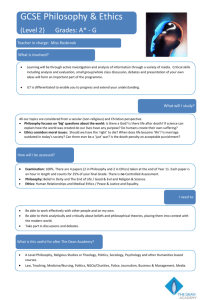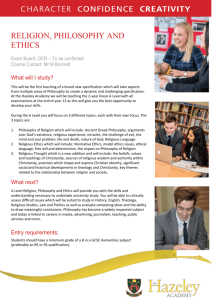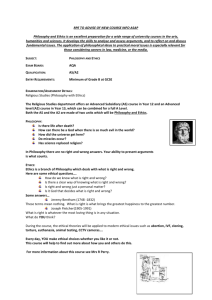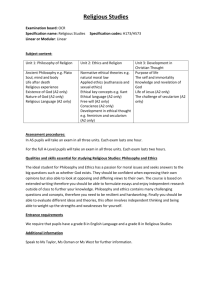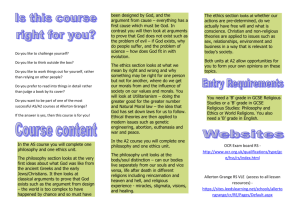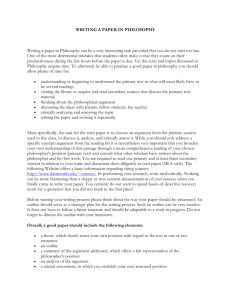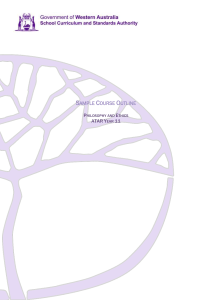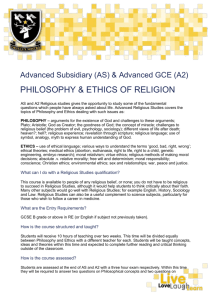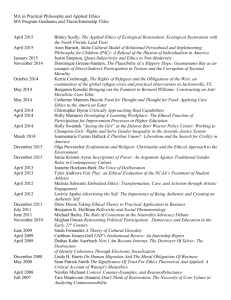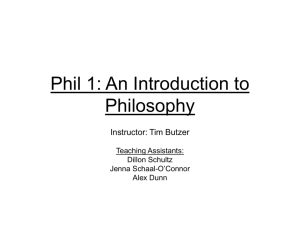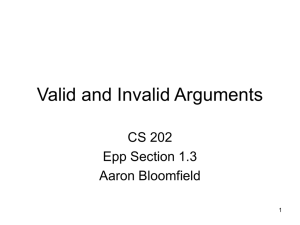Sample course outline - WACE 2015 2016
advertisement
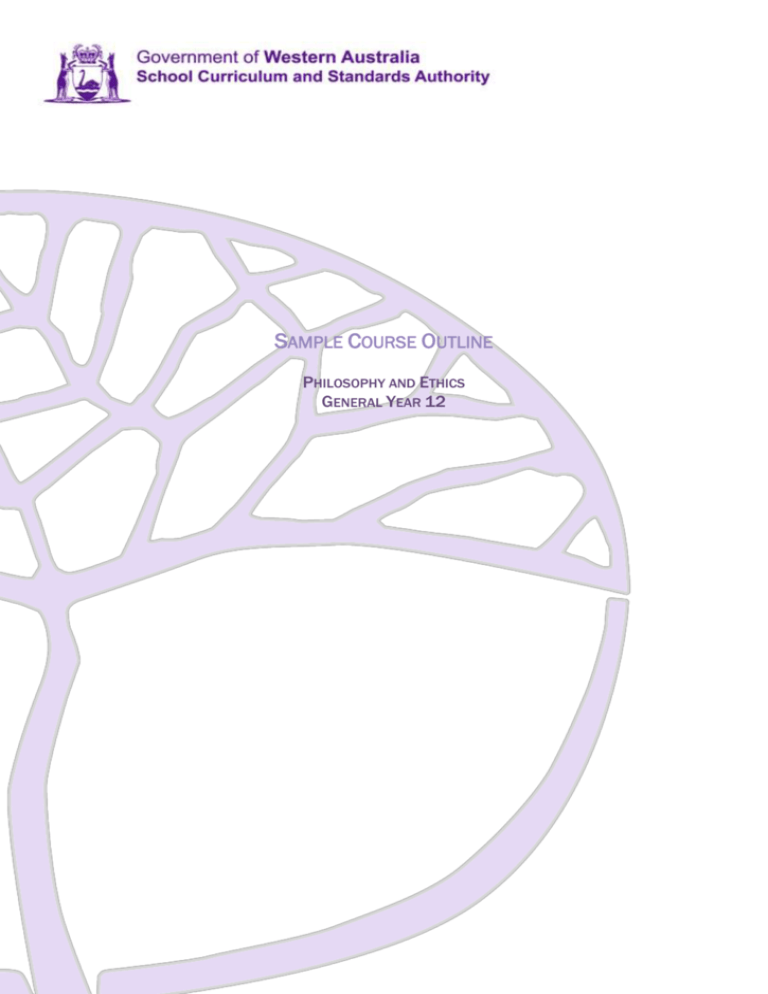
SAMPLE COURSE OUTLINE PHILOSOPHY AND ETHICS GENERAL YEAR 12 Copyright © School Curriculum and Standards Authority, 2015 This document – apart from any third party copyright material contained in it – may be freely copied, or communicated on an intranet, for non-commercial purposes in educational institutions, provided that the School Curriculum and Standards Authority is acknowledged as the copyright owner, and that the Authority’s moral rights are not infringed. Copying or communication for any other purpose can be done only within the terms of the Copyright Act 1968 or with prior written permission of the School Curriculum and Standards Authority. Copying or communication of any third party copyright material can be done only within the terms of the Copyright Act 1968 or with permission of the copyright owners. Any content in this document that has been derived from the Australian Curriculum may be used under the terms of the Creative Commons Attribution-NonCommercial 3.0 Australia licence Disclaimer Any resources such as texts, websites and so on that may be referred to in this document are provided as examples of resources that teachers can use to support their learning programs. Their inclusion does not imply that they are mandatory or that they are the only resources relevant to the course. 2015/39623v4 1 Sample course outline Philosophy and Ethics – General Year 12 Semester 1 – Unit 3 – Reason and persons The key teaching points are not prescriptive and provide only one approach for teaching the unit content. Week 1–2 3–5 6–8 Key teaching points Unit content recognising and evaluating an argument written in natural language in terms of its premises, inferences and conclusions recognising statements in a variety of texts as either argumentative, descriptive, narrative or explanatory understanding modus ponens and modus tollens the distinction between empirical evidence and rational proof inductive and deductive arguments Key teaching points Understanding the difference between statements as either argumentative, explanatory or descriptive Modus ponens and modus tollens as deductively valid inferences Making inferential moves where the premises lend varying degrees of support to the conclusion, i.e. the difference between weak support, moderate support, strong support and deductively valid or certain support The difference between formal proof and empirical evidence in arguments Unit content the concepts of change and causation observation and thought experiment science as a way of classifying the world and constructing our understanding of what is real in human nature different ideas of human nature the relationship between reason and imagination distinction between perception, rational reflection and various sources of imagination Task 1: Critical reasoning Key teaching points What is cause? What is change? Aristotle’s four kinds of causation Thought experiments about change (Ship of Theseus thought experiment) Hume’s problem of induction and the conceptual challenge to causation Thought experiments about cause (Hume’s example of white and black swans or knowledge of the sun rising) Unit content the idea of free will conceptual difficulties with free will, determinism and agency (human action) concepts of action, intention, will, motives and reasons concepts of mind, body and personhood observation and thought experiment types of inquiry: dialectic Task 2: Philosophical analysis and evaluation Key teaching points The idea of cause and the concept of determinism (hard and soft determinism) The concept of free will The concept of the mind and the brain-in-a-vat thought experiment The concept of dialectic Sample course outline | Philosophy and Ethics | General Year 12 2 Week 9–11 Key teaching points Unit content the concept of being ‘an individual’ the social element in individual identity the ideas of personal identity, gender, race, class and ethnicity the relationship between individuals and societies the distinction between contractual and non-contractual relationships observation and thought experiment Task 3: Construction of argument Key teaching points The theory of social determinism The idea of a social contract The concept of being a person (Locke’s emphasis on rationality and legal/moral responsibility) The idea of being an individual and having personal identity Unit content the role of principled decisions in ethics, including: the Golden Rule the greatest happiness principle the categorical imperative the concept of care, including care for, care about and taking care the nature of virtues and vices and their relationship to the development of character and ethical action the ideas of justice, fairness and power relations, including race, gender and class 12–15 Task 4: Externally set task Key teaching points The Golden Rule, or doing to others as you would have them do to you The three formulations of the categorical imperative Aristotle’s idea of the virtues as moral habits that need to be practised in order for actions and human character to be good Aristotle’s idea that a virtue is the mean between the two extremes of excess and deficiency of moral character and action (striking the balance between too much and too little) The concepts of proportional justice and distributive justice when there are imbalances or abuses of power between persons Sample course outline | Philosophy and Ethics | General Year 12 3 Semester 2 – Unit 4 – Reason and culture The key teaching points are not prescriptive and provide only one approach for teaching the unit content. Week Key teaching points Unit content identifying the formal fallacies of denying the antecedent and affirming the consequent identifying some major informal fallacies, including the genetic fallacy, ad hominem arguments, hasty generalisation, argument from irrelevant authority, argument from ignorance and equivocation distinguishing between strong and weak arguments, written in natural language, in terms of inferential strength and cogency 1–2 3–5 Key teaching points Comparing the form of formal fallacies to the form of modus ponens and modus tollens Practical examples of each informal fallacy Examples of a range of arguments in order to evaluate: the acceptability of the premises (acceptable, moderately acceptable, not acceptable) the strength of the inference(s) (weak, moderate, strong, deductively valid) the cogency or overall judgement of the way the premises and the inferences work together to put forward a persuasive argument The concept of cogency (argument persuasiveness) as a product of inferential strength and the acceptability of the premises Unit content the role of metaphor and analogy in inquiry the use of observation, hypotheses and theories in constructing explanations the concept of interpretation criteria for good interpretations, including coherence, consistency, comprehensiveness and consilience types of inquiry: hermeneutics imagination as a necessary element in interpretation the ideas of truth, representation and reality, and their interrelationship the question of objectivity and subjectivity disputes about realism and the limits of interpretation, including modernism and postmodernism Task 5: Critical reasoning Key teaching points The role of metaphors in philosophy (the analogy) The process of observing and using empirical evidence to make truth claims The difference between correspondence theory and coherence theory The concept of realism as opposed to anti-realism Hermeneutics as the philosophical study of interpretation The role that criteria can play in strengthening an interpretation Questioning the reliability of the imagination and the subjective impact that may have on interpretation and truth Sample course outline | Philosophy and Ethics | General Year 12 4 Week Key teaching points Unit content aesthetic concepts, including beauty, taste and judgement perception and aesthetic appreciation the concept of culture, including shared values and social roles the concept of friendship 6–8 Task 6: Philosophical analysis and evaluation Key teaching points The question of beauty as a problematic example of objective truth Perception as a process of physically observing/interpreting things in the world, as opposed to aesthetic appreciation which involves observing/interpreting mentally and/or emotionally Culture as stories about shared identity and values (for example, ANZAC day) Aristotle’s idea of friendship as philia or love The concept of friendship as the standard for all human relationships Unit content how works of art and literature help the understanding of human nature and identity the use of symbols and concepts to understand the way things are the use of symbols, signs and signification (semiosis) to understand the world the process of interpreting works of art and literature interrelationships between personhood, emotion and reason I-thou relationship as a fundamental element of ethics 9–11 Task 7: Construction of argument Key teaching points Understanding the human condition and natural human values (such as pursuing happiness, liberty, friendship, property, care and fairness) I-thou or the concept of self and other Symbols and concepts (language) and the role they play in human moral life (such as caring for a national identity) The moral concept of a canon (art and literature about the identity of a people) Unit content the concept of self-expression and its relation to culture freedom of expression and its limits the concept of rights government interference and surveillance privacy and its limits 12–15 Task 8: Test Key teaching points Freedom of Speech as a right and its limits (defamation of character, sedition, hate speech) The difference between rights as a natural right and a civil or social right Freedom of Speech as a civil or social right and not a natural right The Right of Government to intervene and/or interfere (public security) The Harm Principle Sample course outline | Philosophy and Ethics | General Year 12
